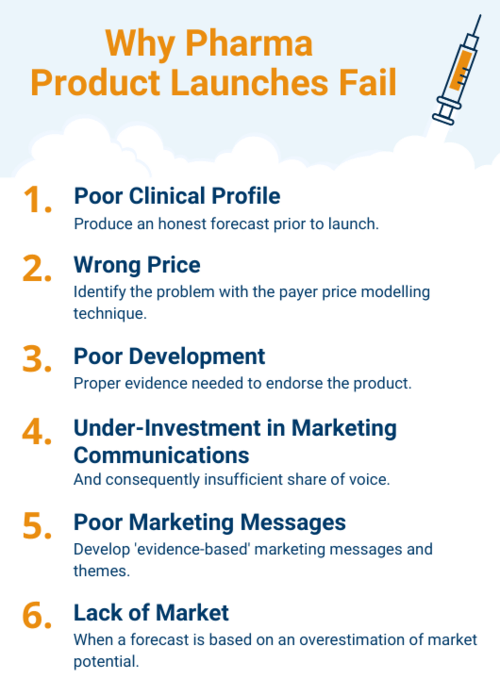Gary Johnson, expert-trainer of the Essentials of Value Pricing for Successful Market Access course and The Pharma Forecasting Course, and his team at Inpharmation have been involved in the pricing and/or forecasting of half of the new molecular entity launches over the past 5 years. We asked him what, in his expert opinion, the reasons are for product launch failures. In his view, there are six main causes:

1. Poor Clinical Profile
Drugs with a poor clinical profile fail to deliver benefits on primary product attributes such as efficacy, safety, ease of administration, etc. There is not much you can do during launch to compensate for that. The solution therefore lies in producing an honest forecast prior to launch. Good forecasters know how to make forecasts based on the profile modelling technique.
2. Wrong Price
The product price premium that a pharma product can command relative to its competitors should be correlated with additional benefits, the number of patients treated etc. If this is not the case, you have a problem. This problem is identified with the payer price modelling technique in our pricing course.
3. Poor Development
Product launches that are preceded by poor product development lack the necessary trials against true competitors, surrogate endpoints, etc. Without this kind of evidence during launch, how then can you endorse the positioning of your drug in the market?
4. Under-Investment in Marketing Communications
The consequence of under-investment in marketing communications is insufficient share of voice. Even a product with great intrinsic value will not reach its potential market share without investing a lot in marketing communications. This is why co-promotion deals and more complex partnerships (e.g. joint ventures) are sometimes necessary when a company lacks the resources to market its drug optimally by itself.
5. Poor Marketing Messages
'Evidence-based' marketing messages and themes that are effective in the pharma arena, are increasingly important as market access hurdles make it more difficult to penetrate the market. Failure to develop such marketing messages will thus increasingly contribute to launch failures.
6. Lack of Market
And last but not least: your forecast might be based on an overestimation of the market potential. In other words: the launch seemingly fails against the background of an unrealistic forecast, while in fact it is the forecast that is wrong. This happens when a forecast is based on wrong assumptions on patient numbers and/or the number that can reasonably be expected to be diagnosed and prescribed medicines.

